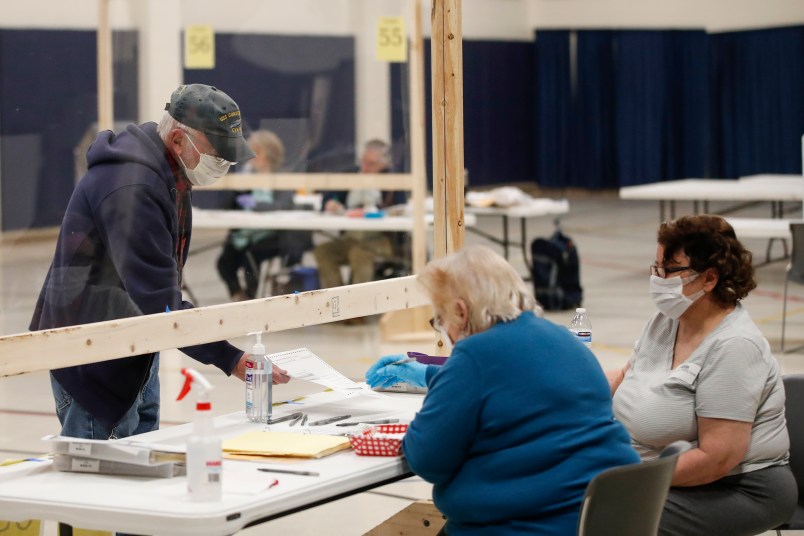Just before election results are due out of Wisconsin, ambiguity from a U.S. Supreme Court decision and an unprecedented number of absentee ballots permeate the end of what has become the standard-bearer for chaotic elections in the time of coronavirus.
As of Monday morning, there was still no centralized guidance from the ideologically-deadlocked Wisconsin Elections Commission on whether ballots with a missing or date-less postmark will be counted.
“Each municipality must determine whether the ballot was postmarked timely,” read WEC guidance released over the weekend.
The commission held an emergency meeting Friday to clear up the questions raised after the Supreme Court decided on the eve of election day that absentee ballots must be postmarked by April 7 to count.
The court decision is fallout from the political stalemate between Democrats and Republicans on whether to postpone the primary amid the pandemic. The Supreme Court’s decision came on the heels of the Wisconsin Supreme Court’s ruling to proceed with the primary as planned.
Clerks reported to the commission “hundreds” of examples of ballots that may have been sent on time, but which had no postmark, illegible postmarks or postmarks with the month and year, but not day.
WEC administrator Meagan Wolfe drafted guidance for the commission, emphasizing that the postal service doesn’t always postmark mail the same day it’s received.
“The Wisconsin Elections Commission directs municipal canvass boards to count a ballot, if otherwise valid, if the board determines, by a preponderance of the evidence, that the ballot was in the possession of a USPS facility on or before April 7, 2020, regardless of whether the ballot return envelope includes a postmark with a date on or before April 7th,” she wrote.
Democrats on the commission embraced Wolfe’s advice, while Republicans pushed for the narrowest possible parameters of an acceptable ballot.
“People were trying to get their ballots in by April 7 and waited until the last moment to do so,” said Commissioner Robert Spindell, a Republican. “If there is no postmark, the ballot should not be counted.”
“I think it’s absurd to pretend clerks who got ballots in the mail on the 8th were not mailed the 7th — you know they were,” said Commissioner Ann Jacobs, a Democrat. “A lot of ballots aren’t going to have a postmark on them or are going to have a wide variety of kinds of marks on them.”
She emphasized a point made by Wolfe, that the Supreme Court was likely using the postmark as a barometer to tell when the ballot was mailed, rather than as an ironclad requirement for a legitimate ballot.
“How many people are going to be disenfranchised over a stamp when they actually put their ballots in on time?” she asked incredulously.
All the commission ultimately agreed upon was definitely counting ballots postmarked by the 7th.
The court’s opaqueness and commission’s ideological impasse leave election officials to decide themselves which ballots count and which don’t.
Reid Magney, public information officer for the WEC, told TPM that “we don’t know how many ballots fall into that category.” Wolfe said previously that she’d been told of “hundreds” of examples of ballots with ambiguous marks.
The unconfirmed number of ballots with substandard postmarks, and whether they’ll be counted, could play into the gap between absentee ballots requested and those tabulated.
As of Monday morning, 1,101,474 ballots had been returned of the 1,284,914 sent. Wolfe said that ballots featuring an unclear postmark “could be included” in the returned total, meaning that they could ultimately be discarded.
Another contributor to the gap may be ballots that, while requested, were never delivered. Wolfe mentioned reports of voters never receiving their absentee ballots and said she was probing the postal service for answers. It is unclear how many voters were affected.
According to the current, unofficial totals, the discrepancy between ballots sent and ballots returned is not too far off from the state’s normal. Per Magney, citing the MIT Elections Performance Index, between two and 12 percent of ballots has gone unreturned in general elections between 2008 to 2016. This year so far, the gap hovers around 14 percent.
While the chasm may be fairly usual, the sheer volume of absentee ballots being returned dwarfs the number Wisconsin usually handles.
The 1.1 million absentee ballots logged as of Monday morning eclipses the entire vote total of the 2016 Democratic primary — both absentee and in-person voting.
“It’s COVID-19, it’s the pandemic,” commissioner Thomsen sighed. “One million-plus people are scared to death and casting absentee ballots. This is not your usual day-in, day-out affair.”







Vote Count Hours Away.
COVID-45 Spike Days Away.
I also read on a techie blog that Foxconn, who successfully swindled Wisconsin into thinking they were getting a massive new plant with massive job hires, has yet to follow through on any of that. Their “innovation centers” are empty, so really, I hope the stupidity of this state continues unabated because it’s awesome to watch.
“…Republicans pushed for the narrowest possible parameters of an acceptable ballot.”
The GOP believes that voting is a precious thing that should be used only sparingly.
Let’s not forget that there was a backlog of requests and there were ballots that were not mailed out to voters.
Redefining cluster fuck.